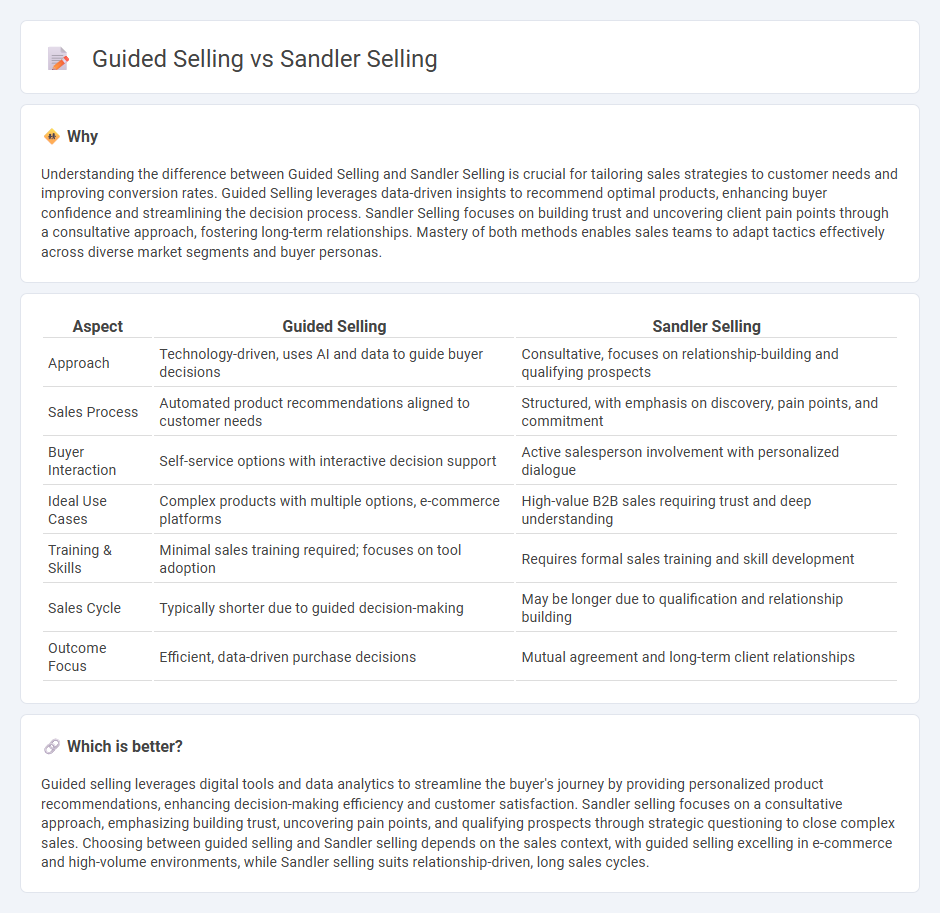
Guided selling employs data-driven insights and personalized recommendations to streamline the buyer's decision-making process, enhancing customer experience and increasing conversion rates. Sandler selling focuses on a consultative approach, emphasizing relationship-building, qualification, and uncovering customer pain points to tailor solutions effectively. Explore how each method can transform your sales strategy and boost revenue performance.
Why it is important
Understanding the difference between Guided Selling and Sandler Selling is crucial for tailoring sales strategies to customer needs and improving conversion rates. Guided Selling leverages data-driven insights to recommend optimal products, enhancing buyer confidence and streamlining the decision process. Sandler Selling focuses on building trust and uncovering client pain points through a consultative approach, fostering long-term relationships. Mastery of both methods enables sales teams to adapt tactics effectively across diverse market segments and buyer personas.
Comparison Table
| Aspect | Guided Selling | Sandler Selling |
|---|---|---|
| Approach | Technology-driven, uses AI and data to guide buyer decisions | Consultative, focuses on relationship-building and qualifying prospects |
| Sales Process | Automated product recommendations aligned to customer needs | Structured, with emphasis on discovery, pain points, and commitment |
| Buyer Interaction | Self-service options with interactive decision support | Active salesperson involvement with personalized dialogue |
| Ideal Use Cases | Complex products with multiple options, e-commerce platforms | High-value B2B sales requiring trust and deep understanding |
| Training & Skills | Minimal sales training required; focuses on tool adoption | Requires formal sales training and skill development |
| Sales Cycle | Typically shorter due to guided decision-making | May be longer due to qualification and relationship building |
| Outcome Focus | Efficient, data-driven purchase decisions | Mutual agreement and long-term client relationships |
Which is better?
Guided selling leverages digital tools and data analytics to streamline the buyer's journey by providing personalized product recommendations, enhancing decision-making efficiency and customer satisfaction. Sandler selling focuses on a consultative approach, emphasizing building trust, uncovering pain points, and qualifying prospects through strategic questioning to close complex sales. Choosing between guided selling and Sandler selling depends on the sales context, with guided selling excelling in e-commerce and high-volume environments, while Sandler selling suits relationship-driven, long sales cycles.
Connection
Guided selling and Sandler selling both emphasize understanding customer needs to tailor the sales approach effectively. Guided selling uses technology and data-driven insights to recommend the best product options, aligning with the Sandler Selling System's focus on qualifying prospects and uncovering pain points. Their connection lies in enhancing buyer engagement through personalized, consultative interactions that drive higher conversion rates.
Key Terms
**Sandler Selling:**
Sandler Selling emphasizes a non-traditional approach where sales professionals act as trusted advisors, focusing on uncovering pain points through strategic questioning and qualifying leads early to avoid wasting time. This methodology relies heavily on building a strong rapport with prospects and using a systematic process to control and guide the sales conversation towards mutually beneficial outcomes. Discover how adopting Sandler Selling techniques can transform your sales efficiency and close rates.
Up-front contract
Sandler selling emphasizes establishing an up-front contract to clearly define mutual expectations and commitment before progressing in the sales process, enhancing transparency and trust. Guided selling integrates this concept by using data-driven insights and AI tools to tailor conversations and establish precise upfront agreements, improving customer alignment. Explore how mastering up-front contracts in both methodologies can elevate your sales effectiveness.
Pain
Sandler Selling emphasizes identifying and addressing the prospect's pain points through a structured questioning process, enabling sales professionals to uncover underlying challenges and position solutions accordingly. Guided Selling leverages AI and data-driven insights to tailor recommendations that directly address customer pain, enhancing decision-making and personalizing the buying experience. Explore how integrating these methodologies can transform your sales strategy and deepen customer engagement.
Source and External Links
What is the Sandler sales methodology? (With example questions) - The Sandler selling system uses a 7-stage process modeled by a submarine analogy, focusing on building trust, qualifying leads, and securing each stage to avoid "sinking" the sale.
Sandler Sales Methodology: 7 Steps to Sales Success - Salesmate - This methodology emphasizes equal investment by buyer and seller, focusing on thorough lead qualification to match the right customers with the right solutions, reducing churn and fostering loyalty.
The Sandler Sales Method: 7 Steps for Intentional Sales Success - Developed in 1967 by David Sandler, this method treats the salesperson as a consultant and stresses building mutual trust and qualification to improve customer attraction and retention.
 dowidth.com
dowidth.com